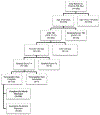Age and sex-mediated differences in six-month outcomes after mild traumatic brain injury in young adults: a TRACK-TBI study
- PMID: 31007155
- PMCID: PMC6571056
- DOI: 10.1080/01616412.2019.1602312
Age and sex-mediated differences in six-month outcomes after mild traumatic brain injury in young adults: a TRACK-TBI study
Abstract
Introduction: Risk factors for young adults with mTBI are not well understood. Improved understanding of age and sex as risk factors for impaired six-month outcomes in young adults is needed. Methods: Young adult mTBI subjects aged 18-39 years (18-29y; 30-39y) with six-month outcomes were extracted from the Transforming Research and Clinical Knowledge in Traumatic Brain Injury Pilot (TRACK-TBI Pilot) study. Multivariable regressions were performed for outcomes with age, sex, and the interaction factor age-group*sex as variables of interest, controlling for demographic and injury variables. Mean-differences (B) and 95% CIs are reported. Results: One hundred mTBI subjects (18-29y, 70%; 30-39y, 30%; male, 71%; female, 29%) met inclusion criteria. On multivariable analysis, age-group*sex was associated with six-month post-traumatic stress disorder (PTSD; PTSD Checklist-Civilian version); compared with female 30-39y, female 18-29y (B= -19.55 [-26.54, -4.45]), male 18-29y (B= -19.70 [-30.07, -9.33]), and male 30-39y (B= -15.49 [-26.54, -4.45]) were associated with decreased PTSD symptomatology. Female sex was associated with decreased six-month functional outcome (Glasgow Outcome Scale-Extended (GOSE): B= -0.6 [1.0, -0.1]). Comparatively, 30-39y scored higher on six-month nonverbal processing speed (Wechsler Adult Intelligence Scale-Processing Speed Index (WAIS-PSI); B= 11.88, 95% CI [1.66, 22.09]). Conclusions: Following mTBI, young adults aged 18-29y and 30-39y may have different risks for impairment. Sex may interact with age for PTSD symptomatology, with females 30-39y at highest risk. These results may be attributable to cortical maturation, biological response, social modifiers, and/or differential self-report. Confirmation in larger samples is needed; however, prevention and rehabilitation/counseling strategies after mTBI should likely be tailored for age and sex.
Keywords: Age factors; common data elements; functional disability; mild traumatic brain injury (mTBI); post-traumatic stress disorder (PTSD); risk factors; sex; young adults.
Conflict of interest statement
Figures


References
-
- Cassidy JD, Carroll LJ, Peloso PM, et al. Incidence, risk factors and prevention of mild traumatic brain injury: results of the WHO Collaborating Centre Task Force on Mild Traumatic Brain Injury. J. Rehabil. Med 2004;28–60. - PubMed
-
- Røe C, Sveen U, Alvsåker K, et al. Post-concussion symptoms after mild traumatic brain injury: influence of demographic factors and injury severity in a 1-year cohort study. Disabil. Rehabil 2009;31:1235–1243. - PubMed
-
- Stulemeijer M, van der Werf S, Borm GF, et al. Early prediction of favourable recovery 6 months after mild traumatic brain injury. J. Neurol. Neurosurg. Psychiatry 2008;79:936–942. - PubMed
-
- van der Naalt J Prediction of outcome in mild to moderate head injury: a review. J. Clin. Exp. Neuropsychol 2001;23:837–851. - PubMed
Publication types
MeSH terms
Grants and funding
LinkOut - more resources
Full Text Sources
Medical
Miscellaneous
